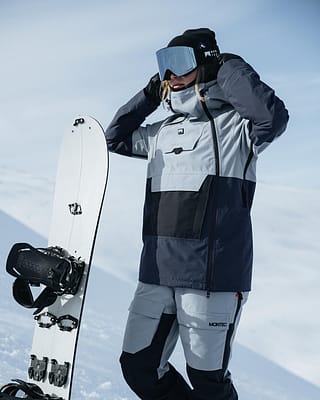How to choose snowboard size
Looking to dial in your setup for the season? We’ve got everything you need to know about how to choose snowboard size, so strap in and let’s get you ready to ride!

“What size snowboard should I get?” It’s a question asked by many riders. And finding the answer can be tricky. Yep, with factors such as height, weight, riding style, terrain, board shape, boot size, and personal preference to consider, where exactly do you start? Here’s a hint: right here.
So, drop in to this guide, and by the end, you’ll be ready to drop the hammer on that purchase. Oh, and while you’re refreshing your gear, why not pick up a MONTEC snowboard jacket and some new snowboard pants?
What’s the right snowboard length for me?
Snowboard size chart
Snowboard sizing charts aren’t an exact science. However, they are a solid place to start if you’re unsure what length to go for. Charts use your height and weight to give a recommended size range – and they massively help narrow things down.
So, start with our chart below and then filter down further based on a few certain factors. These include personal preference, riding style, board shape, and terrain, which all play a part in finding the perfect length. Most snowboard brands also have their own charts, so it’s worth looking at those before pulling the trigger on your next purchase.
| Rider height ft/in & cm | Rider weight lb & kg | Snowboard size cm |
| 4'10" (147cm) | 110-120 (50-54kg) | 128 - 136 |
| 5'0 (152cm) | 115-130 (52-59kg) | 133 - 141 |
| 5'2" (158cm) | 120-135 (54-61kg) | 139 - 147 |
| 5'4" (163cm) | 130-145 (59-66kg) | 144 - 152 |
| 5'6" (168cm) | 140-160 (63-73kg) | 148 -155 |
| 5'8" (173cm) | 150-170 (68-77kg) | 152 -158 |
| 5'10" (178cm) | 160-185 (73-84kg) | 156 -162 |
| 6'0 (183cm) | 170-195 (77-88kg) | 158 - 164 |
| 6'2" (188cm) | 180-210 (82-95kg) | 160 - 166 |
| 6'4" (193cm) | 190+ (86+kg) | 162+ |
Choosing a longer or shorter board
Typically, most instructors recommend a board that stands somewhere between your chin and nose when upright. However, some riders size up or down based on a few reasons. For example, longer snowboards are more stable at high speeds, offer better float in powder, and suit aggressive riders or those with a bigger build. And they’re also great for freeride and all-mountain carving.
Shorter boards, on the other hand, are lighter, better for maneuvering, and ideal for freestyle riding. They’re ace for beginners wanting something more forgiving. In between sizes? Think about what terrain you ride most and what kind of feel you’re after – such as playful and nimble or stable and powerful. With that all said, let’s take a deeper look at when you might choose a shorter or longer snowboard.
Weight and height

Both height and weight factor into sizing, but weight is more important. A rider’s weight determines how much pressure is put into the board, affecting flex and response.
If you're on the heavier side for your height, size up a few centimeters or inches for better support and stability. If you’re lighter, a shorter board is easier to control. Have your eye on a particular design? Check the manufacturer’s weight range to make sure you’re within spec.
Riding style and terrain
Your preferred riding style — and where you ride — should help guide your board length and shape, especially as you progress. For example, freestyle and park riders typically go shorter for effortless spins and tricks. These boards are lighter and easier to maneuver, making them perfect for rails, jumps, and side hits.
More of an all-mountain rider? Mid-length boards are the go-to here. They offer the versatility needed to ride groomers, sidecountry stashes, and even the odd powder day without missing a beat.
Freeriders and powder hounds often size up for extra speed and float. Longer boards stay more stable at high speeds and help keep you on top of deep snow — essential for big back bowls, steeps, and off-piste terrain.
Splitboarders and riders tackling long backcountry tours benefit from longer, stiffer boards that offer stability, glide, and dependable performance in varied conditions. When building out a quiver, it’s also smart to choose boards tailored to specific terrain. Freestyle, powder, and resort carving boards should vary in length, width, and flex to match the unique demands of each ride.
Ability level
As you become better, your board size preference might change. For example, as a total beginner, you’ll likely benefit from a slightly shorter board, as they’re easier to turn and maneuver and are more forgiving. In fact – when learning – erring on the shorter side will help build confidence and master technical skills faster.
Then, as you progress into intermediate, take a look at the more mid-range sizes. And advanced riders? They might size up or down depending on their style and terrain preferences.
Board shape

Always check what shape snowboard you ride and factor that into your size choice. This is especially true for powder-focused or surf-style boards, as sizing can differ greatly from ‘standard’ designs.
So, what other shapes are there? Directional boards are designed to go one way. These often ride longer than their actual length because of an elongated nose and shorter tail. This is down to the length between the contact points (the widest points on the board) rather than the total length. True twins ride more true to size. However, volume-shifted boards (short and wide) are built to be ridden shorter than standard. This gives them extra agility and playfulness in tight spaces, such as when swerving through the trees.
What about snowboard width?
Board width matters just as much as length. And the width often complements the length. For example, longer boards are wider to accommodate larger riders with big feet. If you’re intrigued about sizing down, just keep in mind that doing so might create heel and toe drag, as shorter designs often have narrower widths.
Riders with size 11+ feet might need a ‘wide’ board to avoid toe and heel drag. These sizes usually include a ‘W’ to signify the extra width (such as 156W). Don’t choose too wide, though – the snowboard will feel sluggish, and you’ll find it difficult to get on your edges. And remember — a more splayed stance (such as duck-footed with larger angles) shortens the effective length of your boots. However, less splayed stances lengthen your boots across the board. For the best fit, check the brand’s recommended boot size for each board width — especially if you’re carving or riding steep terrain.
Wrapping up
Choosing the right snowboard length is all about balance. Start with the chart, then adjust based on your weight, riding style, skill level, and shape. If in doubt, check the brand's recommendations or talk to someone who’s been riding for a while for extra advice.
The right size makes all the difference and riding a board that’s the perfect size will help you progress and dial you in to the mountain. Love this article, or think we missed something? Hit us up at crew@montecwear.com. We’re always here to offer more advice or talk about all things snow!
Related reading:
